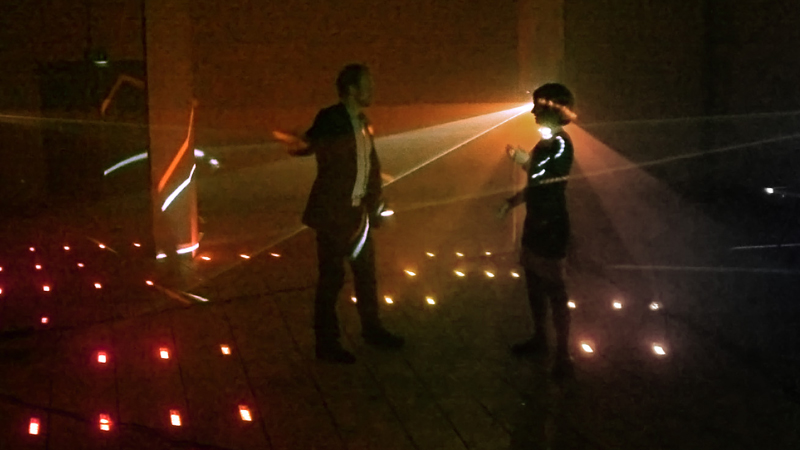CAAD lecture series #35: Tomasz Jaskiewicz + Stefan Dulman
CAAD lecture series: Tomasz Jaskiewicz + Stefan Dulman, TU Delft
Realizing Complex Interactive Architecture
25.02.2013 17:00 HPZ F
Part I – Dr. Tomasz Jaskiewicz (Faculty of Architecture, TU Delft)
The concept of interactive architecture (iA) stems from the premise that buildings and built environments can be formed and trans-formed in continuous and direct response to needs and activities of their inhabitants, while also, in turn, reciprocally influencing future needs and activities. The past decade has seen a revival of iA ideas, made possible with latest technological advancements and following current social trends. Among those, projects investigated at the TU Delft’s Hyperbody chair investigate new experiences and spatial qualities that iA can deliver, define the new role of an architect in iA and verify the societal need for interactive buildings. Yet despite all these explorations, to date all cases of interactive architecture are just experimental and highly constrained in scale and scope. How do we move from these limited, small-scale projects to realising truly interactive buildings, public spaces and cities?
Part II – Dr. Stefan Dulman (Faculty of Computer Science, TU Delft)
Large-scale installations containing embedded systems (sensors, actuators, displays, etc.) become difficult to design and manage once the number of devices increases over, say, a few hundreds. The traditional approach of using a central computer to coordinate such a network, if feasible at all, has a number of disadvantages such as its prohibitive high price. A different design approach is to remove the central computer completely from the solution and focus on a distributed systems approach. A number of cheap computing elements are deployed in the system and the desired network behavior will be created from their interaction. In this lecture, we will focus on the concept of emergent behavior occurring in large networks. We will show how it can be used as a programming primitive and briefly introduce a few examples.
Dr. Stefan Dulman received the BS and MS degrees from “Gh.Asachi” Technical University, Iasi, Romania in 2001 and respectively in 2002. He was awarded the PhD degree for the thesis entitled “Data-centric architecture for wireless sensor networks” at the University of Twente, the Netherlands, in 2005. He started his research career by focusing on the area of wireless sensor networks. Some of his research results being integrated in the products of the Ambient Systems BV, a Dutch SME specialized in providing wireless solutions for the transport and logistics scenarios, where he acted as founding member and senior researcher between 2004-2010. Between 2009-2013 he held the Assistant Professor position at the Delft University of Technology, Embedded Software Chair. His current research interests include self-adaptive aspects of large-scale embedded systems (wireless sensor networks, robotic swarms, mobile ad-hoc networks), spatial computing, interactive distributed systems. He pays a particular interest to the real-world applicability of his research, especially in the field of interactive architecture. He was involved in several research projects, both at European level (Eyes, Wisebed, Demanes) and Dutch national level (Free, LoCare). He has co-authored more than 50 research papers in peer-reviewed publications.
His full CV can be found here: http://www.linkedin.com/in/stefandulman
Dr. Tomasz Jaśkiewicz is an architect, urban designer, academic researcher and educator. After finishing his undergraduate studies in Architecture and Urban Planning at TU Gdansk in Poland, he joined the Hyperbody chair at the faculty of Architecture, TU Delft in the Netherlands. There, in 2005, he obtained his Master of Science degree as an Architect, with a thesis on a real-time participatory urban planning toolkit “Paracity”. Afterwards he continued this work as a leading researcher on a series of Protospace Demo projects, investigating novel applications of computational techniques and interfaces to participatory and collaborative architectural and urban design. In following years he joined the architecture firm ONL [Oosterhuis_Lénárd] where he worked as architect and project manager, bringing much of his earlier studies to practice. In 2007 he has started his PhD research at TU Delft, in which, supervised by prof. Kas Oosterhuis, he developed an integrated design framework for development of evolving interactive architectural ecosystems. Next to his research, he also works as an academic teacher, among others having initiated and coordinated the interdisciplinary undergraduate minor program “Interactive Environments”. Since 2011 he has been the manager of TU Delft’s Architecture design laboratory “protoSPACE”, an innovative prototyping facility and think-tank where numerous research, commercial and educational projects on out-of-the-box applications of technology to architectural design are being executed. In all his projects, Tomasz transgresses the boundaries between conventionally established disciplines and practices. He explores new paths leading towards creation of architecture approached as a complex adaptive system. In this way, he aspires to produce artificial spatial ecologies operating in a proactive symbiosis with their human inhabitants and with the natural environment.
His full CV can be found here: http://www.jaskiewicz.net/cv

 Follow
Follow
